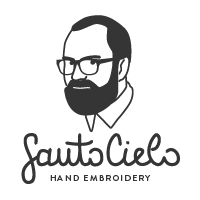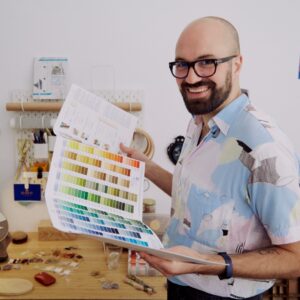In my childhood, I remember being surrounded by fabrics, threads and dressmakers. For many years, my mother owned a haberdashery in the little town where I was born, and I tend to think this had an influence on my later decision to study textile design. Although I earned my degree in Industrial Design, at the Escuela Universitaria Centro de Diseño in Montevideo, Uruguay, and have since worked in many design and artistic fields, I think of myself first and foremost as an Embroidery Artist.
At the end of our university courses, a friend and I got together to do a joint degree thesis, researching hand embroidery as a textile alteration technique and also national identity. We created an interview/workshop system where embroiderers, in this case, women of various ages, would tell us stories relating to their craft, teaching us one or two stitches at the same time.
Listening to and learning from these women was a very enriching experience and opened up a spectrum of possibilities as to what we could achieve with hand embroidery. Thanks to them, we were able to discover and learn beautiful techniques such as crewel-work, cross-stitch, beading, Russian embroidery, and needle painting. The rhythm of the stitches and one’s level of involvement in the process and materials deeply captivated me. Embroidery has a lot to do with improvisation, feeling and leading the materials, and acting intuitively, which results in an art form that is authentic and emotional.
My interest in embroidery was put on hold for a couple of years while I worked on a full-time basis in fashion marketing. It wasn’t until I lost my job that I decided on the course I wanted to follow in my professional career.
It all started when my niece was born: I made a gift for her using multiple embroidery techniques, which caught the attention of family and friends. That’s how Santo Cielo – an artistic anagram of my name – began in mid-2017. Using this platform, I celebrate hand embroidery by broadcasting both my own work and that of other artists. After creating this platform and before emigrating from Uruguay in 2018, I did a series of workshops that allowed me to further impart my passion and skills to others, just as those women did for me.
In 2020, after travelling around some cities in Europe trying to find my new home, I decided to return to Berlin, a city that constantly inspires and surprises me. In my room, I have set up a corner for embroidery work next to the window – natural light is very important. Each project is a new display of threads, hoops/frames, fabrics and needles on my little desk, and with every new piece I get a new opportunity to perfect my stitches. It is so rewarding to reflect on my own progress; I work with more confidence and speed and rely less and less upon trial and error, which, believe me, embroidery involves a lot of.
Nowadays, I focus mostly on portraits of animals and humans using the needle painting technique. Many portraits are created in response to customer requests I receive through Instagram; through family photos, I get involved in people’s lives to create a memory they can treasure for years to come. I deal with selfies, pets in the garden, birthday celebrations, holidays at the beach, and many other everyday situations that will be transformed by needle and thread (and many hours) into something unique and lasting. I think the most important moment of my work is when the portrait meets its new owners; it is a mixture of emotions – mine and theirs – that I can’t quite explain.
I also try to carry out my personal projects in between commissions. With these, I give myself more freedom to experiment with techniques, materials, dimensions and finishes. I tend to find inspiration in nature, everyday life, and things that make me feel nostalgic.
I would like to continue my studies at an academy to further explore and master the wide world of embroidery. Experimenting and learning by myself has brought me a long way, but I find a great beauty in the verbal transmission and mimetic acts between master and apprentice in the sharing of this knowledge across generations.
I am grateful that the community of fellow embroidery enthusiasts has grown a lot in recent years. We are not only preventing the technique from falling into disuse, but also encouraging experimentation with, and new approaches to, a timeless art form.



